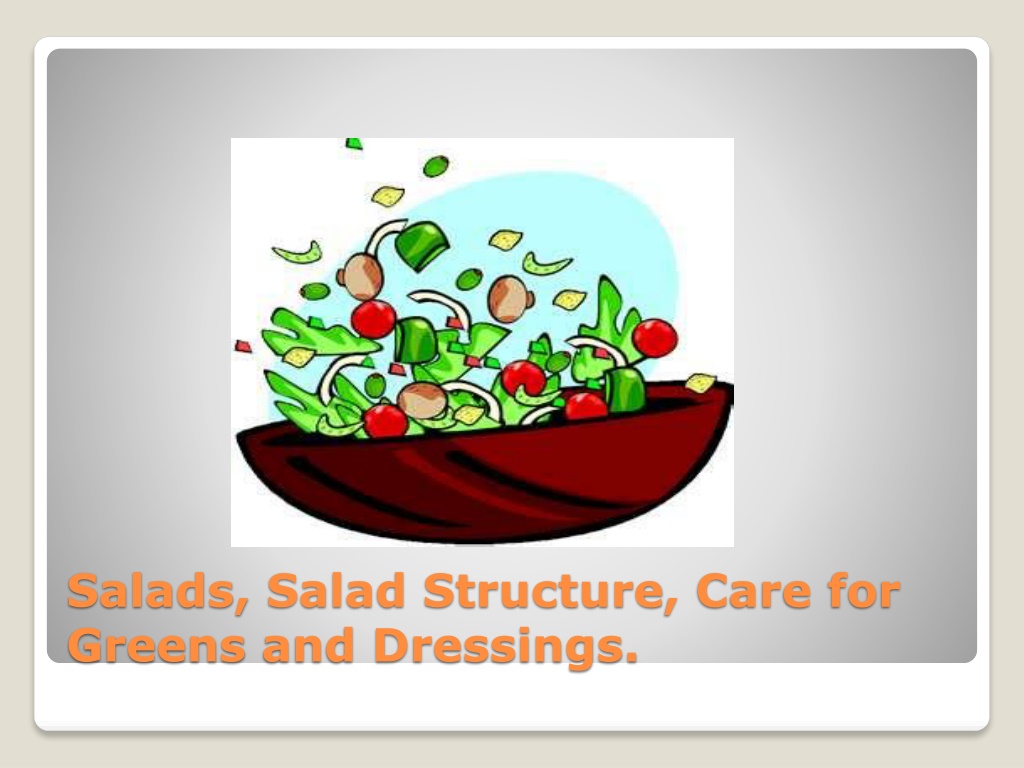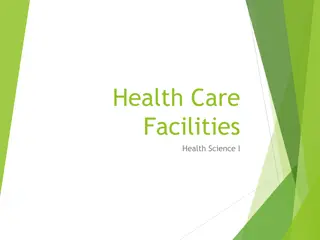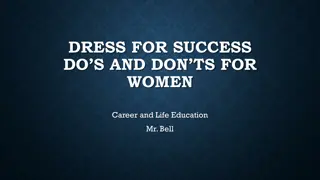Essential Guide to Salad Structure, Greens Care, and Dressing Types
Learn about the main components of a salad, how to care for salad greens, different types of dressings like vinaigrette and mayonnaise-based, and tips for preparing and storing salads for optimal freshness and flavor.
Download Presentation

Please find below an Image/Link to download the presentation.
The content on the website is provided AS IS for your information and personal use only. It may not be sold, licensed, or shared on other websites without obtaining consent from the author. Download presentation by click this link. If you encounter any issues during the download, it is possible that the publisher has removed the file from their server.
E N D
Presentation Transcript
Salads, Salad Structure, Care for Greens and Dressings.
There are 4 main parts of a salad: 1. The base in a green salad, this is usually lettuce, romaine, or additional types of greens. 2. The body in a green salad, this is usually a protein like chicken of ham. 3. The dressing there are two types, a mayonnaise base or a vinaigrette. 4. The garnish this is any product used to finish or enhance the salad, like parsley, basil, chives or olives. The Structure of Salad
Composed salads are arranged either in the serving container or layered. Tossed salads are usually greens and small bite size vegetables. Tossed and Composed salads:
Crisp up greens by placing in ice water for a few hours before serving. Drain thoroughly before serving. Greens may be broken or shredded according to the purpose. Do no over handle or greens become bruised and wilted. Store in a plastic bag. Do not wash until you are ready to use, as the greens will rust. Never freeze. How to Care for Salad Green:
Keep washed and drained greens wrapped in a dry paper towel and refrigerate in a plastic container or a large plastic bag. To prevent browning after washing and serving, tear greens instead of using a metal knife. Tearing adds more texture. Tips:
Add flavor Add color Add fat Add calories Salad Dressing:
Vinaigrette a mixture of oil, vinegar and seasoning. Formula for a Vinaigrette = 3 to 1 3 oils to 1 vinegar Example: 1/3 c. olive oil 2 T. white wine vinegar 1 t. Dijon mustard Other examples: Walnut oil red wine vinegar Sunflower seed oil balsamic vinegar Canola oil apple cider vinegar Flavorings: Herb, spices, citrus zest, and berries. Two Different Types of Dressing: Vinaigrette
Mayonnaise Based = The base of the dressing is mayonnaise and seasonings are added. This dressing has a thicker consistency. Types: 1. Ranch 2. Blue Cheese 3. Tomatillo (Caf Rio) 4. Thousand Island Mayonnaise Based
The dressing should complement the other flavors in the salad. Vinaigrette a mixture of vegetable oil, vinegar, and seasonings. Mayonnaise a thick, creamy dressing that is an emulsion of oil, vinegar, egg yolk and seasoning. Emulsion: A mixture of one liquid with another with which it cannot normally combine smoothly oil and water being the classic example. Which dressing should you serve?
#1 Rule Do Not put the dressing on or salt a salad until just before serving. Prepare salad dressing 2-3 hours before serving and chill. Choose fresh, quality products and prepare salad just before serving. Salads should look neat. Principles of Salad Making:
Handle greens as little as possible. Avoid too much dressing. Break or tear greens into bite size pieces. Ingredient should be well drained and dry. Combine crisp textures with soft textures for contrast. Toss with a fork to give a tossed rather than smashed appearance. More Principles:
There are 4 main types of salads: Appetizer Main Dish Accompaniment Salad Dessert Salad When preparing a salad the first question to ask . . . . What role will the salad play in the meal?????
Small salad Served before the main course Conservative some greens and 1 or 2 additional vegetables. Role of the Appetizer Salad: For a starter to stimulate the appetite and is served at the beginning of a meal. Make with crisp greens, fruits or raw vegetables, and keep the servings small. Appetizer Salad:
Large salad with lots of greens Must contain 4 of the 6 nutrients Must be filling, substantial and satisfying. Role of the Main Dish Salad: Make it with meat, fish, eggs, poultry, vegetable, fruit or a combination of fruit and cheese. This salad is served in a meal size portion and can be served hot. Main Dish Salad:
Vary in size depending on the main dish Usually served on the main dish plate Could be a fruit, pasta, or green salad Role of the Accompaniment Salad: This salad should contrast well with the rest of the meal in color, flavor, and texture. Use crisp greens, fruits, or vegetables whether raw or cooked. Accompaniment Salad:
This may be a sweetened, molded or frozen salad made of fruit gelatin or fruit mixture. Whipped cream is usually added to the dressing. This salad furnished the meal with a color, flavor and texture treat. Dessert Salad:
Vitamins Minerals Fiber Protein Carbohydrates Fats Nutrients in Salads:
Dressing Lab: 1. Each lab will make a dressing. Again this will be a buffet style lab. 2. All dressings will be placed on the supply table. 3. As you taste test the dressing you will as your lab group fill in a chart like the following one:
Salad Lab: 1. Each lab will make a specific type of salad and dressing. Again this will be a buffet style lab. So everyone will be taste testing each different salad and salad dressing
Dressing Evaluation: Dressing Did you like it or not? Explain why you like or disliked it! List some of the flavors in the dressing you liked or disliked! What would have made this dressing better? #1 #2 #3 #4 #5 #6 #7



























